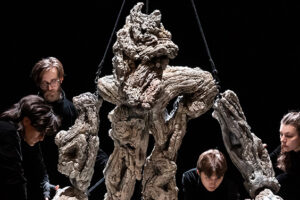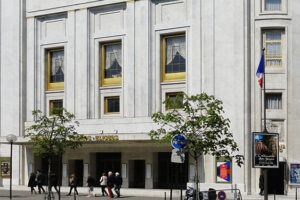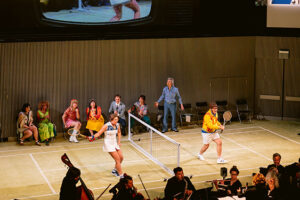
I completely missed The Enchanted Island during the Met’s 2011-12 season, both in the house and in the HD presentation. Even on Sirius, I had only heard snippets of the performance. So I was pleased to receive the newly released DVD
version of the Met HD performance on the Virgin Classics label. After a couple of watchings/hearings, however, I realized what I would really like to have received: a “highlights of The Enchanted Island DVD.”
This self-described “baroque pastiche” is actually quite a remarkable accomplishment by its author and deviser Jeremy Sams (who credits the original idea to none other than Peter Gelb.) The strange combination of plot elements from Shakespeare’s The Tempest and A Midsummer Night’s Dream thrown together on Prospero’s island singing the music of Handel, Vivaldi, and Rameau is in itself quite a creative coup.
The libretto is sometimes graceful and witty, but sometimes clunky and turgid. And while the entire project is imaginative, clever, and beautifully produced, in the end it only partially succeeds. Sublime scenes are abruptly followed by ridiculous or cloying ones, and the first half of the pastiche is far too long and filled with inconsequential introductory arias for every character.
Only in the second half do things begin to come together into a cogent story line. Sams’ finest theatrical conceit is the fleshing out of the character of the sorceress Sycorax, only mentioned in The Tempest, and her son Caliban, now enslaved by Prospero.
The production by Phelim McDermott (and associate director/set designer Julian Crouch) is quite effective. The brilliant combination of two-dimensional 18th century flats with magical animation and projection effects is a visual feast that contributes mightily to the “enchanted” scena of Prospero’s island. Brian MacDevitt’s lighting occasionally works, but too frequently plunges the stage into darkness and shadow.
Costumes by Kevin Pollard work well, especially those for the fantastical characters. Only Danielle deNiese’s rather dumpy Ariel costume and that for Placido Domingo’s Neptune (looking a bit like an oceanic Santa Claus) fall seriously short.
The production works best when in the hands of Joyce diDonato and Luca Pisaroni as Sycorax and Caliban. Both these singers understand that baroque music must be sung with much honesty, passion, and truth if it is to be taken seriously. DiDonato brings great dignity and magnificent singing to her Sycorax, whether in a jealous fury or a reflective melancholy.
She also makes sounds from the depth of her voice that almost sound inhuman. The effect is magical. Pisaroni, too, makes his Caliban a three-dimensional monster/man with real human needs. The Sycorax/Caliban scenes are by far the most successful moments of the evening.
The Midsummer lovers are well sung by Paul Appelby, Elliot Madore, Layla Clare, and particularly Elizabeth deShong, who is inexplicably left off the cast listings in the booklet accompanying the DVD. I found many of their scenes problematic, however, because the director seems not to be sure whether we are playing comedy of manners or outright farce. Most of their scenes together are amusing, but again the writing gives little opportunity for these characters to develop any depth or seriousness of intention. The romantic aspects of the Midsummer lovers are buried under increasingly desperate attempts to get laughs.
Neptune was written for Domingo, and his scene at the end of the lengthy first act much enlivens this ending. With mermaids bobbing about, Domingo’s entrance as an ecologically concerned God feeling his powers diminishing is one of the great visual triumphs of the production. The role sits in the comfortable range of Domingo’s current vocal estate, and he shows here something I never knew he had: real comic timing. And while he occasionally looks like isn’t sure what opera he has stumbled into, his presence is commanding and effective for the most part.
The great countertenor David Daniels is Prospero, and I had serious concerns about his first scene where he instructs Ariel to bring up a storm. I thought his usually pure tone sounded grainy and breathy; fortunately, he completely redeemed himself with a beautiful second act where he makes not a single vocal misstep.
Our Ariel is the beautiful soprano deNiese. Alas, she is working way too hard and way too chirpily, substituting perkiness for character. Never can we believe in Ariel’s desperate need to win her freedom from Prospero; Ms. deNiese can only manage whiny disappointment where real need should be evident. Now, the role has been written as a combination of Ariel and Dream’s Puck, but what it cannot be (and, alas, is here) is Tinkerbell. It should be said, however, that the audience seemed to adore her antics.
Lisette Oropesa brings her silvery soprano to Miranda, and the high countertenor Anthony Roth Costanzo enlivens the second act with high spirits and remarkably pure tone. William Christie conducts with his usual baroque dignity but one wishes for some middle ground between the stately and the rollicking. The Met Chorus and ballet do excellent work.
So, my “highlights DVD” wants all of DiDonato and Pisaroni, Daniels’ second act, the delightful second act dance sequence by Graciela Danielle, and much of Domingo’s deus ex machine Neptune. I think The Enchanted Island suffers from “Sally Field syndrome”; it keeps saying “like me, you really like me” to the audience. It’s just trying too hard.

























Comments